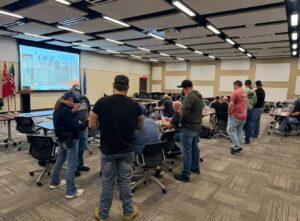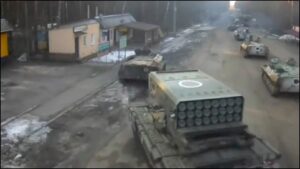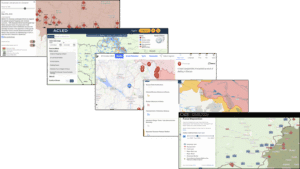In This Issue
Operations: Advanced Human Trafficking Training and Joint Law Enforcement Operations: Oklahoma, Operation Fins Up: Mississippi
Events: Task Force Expedition XVII – Dallas, TX
OSINT Tradecraft: How the Ukraine Conflict Changed OSINT Forever
Who We Are
The Skull Games Task Force employs Open Source Intelligence to IDENTIFY sexual predators and their victims, enabling law enforcement to INTERDICT the cycle of abuse. Our mission is to liberate survivors and EMPOWER them with the opportunity for a life of hope, healing, and freedom. The Task Force provides direct support to law enforcement through small teams or as a massive expedition, bringing together the collective capability of more than 400 elite volunteers. This counter-sexual exploitation offensive leverages considerable expertise and resources to fight human trafficking and sexual exploitation. With us as the HUNTERS, we get into the heads of predators, in our own “SKULL GAME”…
Operations Summary – September 2025
by Olinda Cardenas
- Predators Arrested: 13
- Victims Recovered and Offered Assistance: 15
- Individuals Trained in Countertrafficking: 391

In September, Skull Games continued advancing its mission to equip and empower law enforcement across the U.S. with the tools, data, and training needed to combat human trafficking. Each partnership this month turned intelligence into action, saving lives and strengthening communities.
Shawnee, Oklahoma
Skull Games concluded an Advanced Human Trafficking Training in Shawnee with a one-day joint operation alongside local and federal partners.
Results:
- 3 arrests, including a local fire chief, for solicitation, computer crimes, and facilitation of prostitution
- 2 women and 3 children safely recovered
This operation served as a sobering reminder that exploitation often hides behind positions of trust. The team continues across Oklahoma, standing shoulder to shoulder with law enforcement to protect the vulnerable and hold predators accountable.

Norman, Oklahoma:
Wrapping up a strong week in Norman, Skull Games worked shoulder to shoulder with local, county, and state officers on advanced human trafficking investigations.
Results:
- 3 exploiters arrested
These arrests highlight the growing capability of Oklahoma agencies to leverage intelligence-led investigations and expose predators who once operated in the shadows.
District 27 Task Force – Oklahoma
After attending Skull Games training, the District 27 Task Force conducted three independent operations across the state.
Results:
- 15 buyers arrested
- 5 victims recovered
- 1 trafficker identified
These results demonstrate how training multiplies its impact beyond the classroom, empowering task forces to apply advanced OSINT methods and disrupt exploitation networks within their own jurisdictions.
Operation Fins Up – Oxford, Mississippi
In partnership with Mississippi Attorney General Lynn Fitch and a coalition of federal, state, and local agencies, Skull Games supported Operation Fins Up, a two-day operation targeting traffickers and recovering victims.
Results:
- 5 victims recovered
This effort emphasized the power of collaboration among agencies like HSI, U.S. Marshals, Lafayette County Sheriff’s Office, and Oxford PD. Together, these partnerships continue to prove that when law enforcement stands united, traffickers lose – and freedom wins.

Upcoming Task Force Expedition XVII – Dallas, TX
by Olinda Cardenas
Skull Games will launch Task Force Expedition XVII in Dallas, Texas, from October 17–19, 2025, hosted at The Banner House at T Bar M. In partnership with M42, a global leader in artificial intelligence and digital transformation, this expedition will unite Skull Games’ volunteer OSINT Task Force to identify sex traffickers and victims in real time, passing leads directly to law enforcement partners for action.
The event, supported by the Rochon Family Foundation, highlights a shared mission to bring darkness to light and end sexual exploitation. As Skull Games Founder and Executive Director Jeff Tiegs notes, “Our mission is to identify and expose sexual predators…to disrupt their operations, uncover their identities, and bring them to light.”
Expedition XVII continues the organization’s legacy of fusing technology, intelligence, and human compassion to protect victims and hold predators accountable.
Those interested in learning more, donating, or attending can contact Lauren Norris at lauren@skullgames.org.
OSINT Tradecraft: How the Ukraine Conflict Changed OSINT Forever
by Tom Phelan
Early morning, February 2022, the world saw Russia invade Ukraine. Many of us learned about it not from mainstream news or a government briefing, but from tweets of OSINT analysis of Google Maps traffic function and IP cameras mounted on a Ukrainian border crossing. Within seconds, the timestamped feed captured the first Russian armored vehicles crossing the line, and ordinary people all over the world knew the war had begun. That moment triggered more than the start of an invasion. It marked the beginning of a new era for OSINT: a distributed, civilian-led intelligence network unlike anything the world had ever seen.

Cameras at the Belarusian-Ukrainian checkpoint Senkovka-Veselovka capture a convoy crossing the border from Belarus to Ukraine on Feb. 24 (State Border Guard Service of Ukraine/EYEPRESS/Reuters).
A War Watched in Real Time
The world has watched wars unfold before through the lens of corporate media and government briefings. The Ukraine conflict is different: Smartphones are everywhere, IP-based cameras dot the landscape, Maxar satellites release new high-def imagery daily, and social media was the battlefield’s open window.
- IP Cameras: As Russians advanced, OSINT researchers combed Shodan and Censys, finding unsecured traffic cams along highways and checkpoints to monitor troop movements.
- Social Media Tips: Observers on the ground, many of them ordinary Ukrainians, reported the tanks in their backyard, shared geotagged photos of missile systems on their commute to work, and thereby gave OSINT experts fuel to verify and map operations.
- Satellite Imagery: Maxar and other providers released high-resolution imagery showing convoys stretching for miles, battle damage, and even possible war crimes. This data, once restricted to government analysts, was now in the hands of anyone who cared to look.
The People Behind the Fight
To understand why this OSINT revolution happened, you can’t just look at the tools. You have to look at the people. Many of the individuals who became prominent in those first chaotic months weren’t intelligence professionals. They were students, hobbyists, journalists, veterans, and tech workers. But what was driving them if it wasn’t money or orders?
For Ukrainians, it was a mix of emotions. Surprise, fear, anger. It’s hard to believe your home could become a warzone, but when it set in, fear and anger drove many to try to help their military anyway they could. The rest of Europe also felt a degree of fear that a full-scale war might spread across the continent. Anger and fear grew as Ukrainians watched atrocities unfold in Bucha and Mariupol in real time.
Many felt a moral pull: a sense that if they could help, even just by identifying a geotagged photo, they should. OSINT investigators and tech professionals worldwide discovered a very valuable way to leverage their skills, perhaps for the first time. But for Ukrainians, this wasn’t abstract, fun, or a hobby; it was survival. Families sent loved ones to the front. Neighbors disappeared into territorial defense units. A tweet or message on Telegram about a missile threat wasn’t just social media; it was valuable intel protecting someone’s family. This human dimension powered the OSINT explosion.
Tradecraft Evolution
As more people jumped in, OSINT tradecraft matured rapidly. Techniques that had once been niche suddenly became mainstream:
- Geolocation Skills: By matching buildings, treelines, and road curves to satellite maps, volunteers confirmed the locations of everything from artillery positions to destroyed civilian buildings.
- Timestamp Analysis: Correlating shadows, light, and posted times helped debunk fakes and prove what was happening when.
- Cross-Platform Verification: Analysts pulled clues from TikTok, Telegram, Twitter, and Facebook, combining them into coherent intelligence products.
- Archiving: Groups began preserving digital evidence of war crimes (like facial recognition data) in real time, knowing governments or platforms might not.
OSINT tradecraft was easily practiced, then taught in real time by the community itself.
Global Momentum
Among the loudest and clearest of those early voices was the Dutch OSINT community.
- Oryx, run by Bellingcat veterans Stijn Mitzer and Joost Oliemans, became the most trusted tracker of OSINT confirmed equipment losses. Their method was simple but effective: only count what can be confirmed. News media and governments alike heavily relied on them for battle damage assessments.
- Another Bellingcat veteran, Nico Dekens (well known in the OSINT community by his handle “Dutch OSINT Guy”) was a critical teacher of the masses surging to help with the Ukraine conflict. He is also a hero to Skull Games for his contributions to counter human trafficking.
- Bellingcat OSINT investigators were so effective at tracking war crimes that they were actually banned from Russia as an undesirable
From Data Overload to Advanced OSINT
The power of crowdsourced intelligence collection was on full display when Ukrainian civilians/soldiers reported military activity online, sometimes even tagging the Ukrainian military. These reports came out in a mass never seen before. That led to experts analyzing and retweeting relevant reports with their commentary, creating civilian-driven situational awareness. This naturally occurring intelligence architecture went even further by collaborating with non-profits, think tanks, and hobbyists to create real-time interactive maps of the invasion. Non-profits and think tank organizations like ACLED, CSIS, and ISW provided interactive maps with their daily commentary. Ad-revenue-based OSINT websites like LiveUA, UAWarData, and MilitaryLand.net added to live mapping of the conflict, even showing their live reporting feed along with it. This led to the unprecedented accessibility and visibility of wartime intelligence.

This process changed not just how wars are documented, but how people see their role in global events.
The Ukraine crisis didn’t just change OSINT; it democratized intelligence.
This isn’t the story of a single war.
It’s the story of a new kind of global volunteer force.
Final Thoughts
That same human drive echoes today in the OSINT fight against human trafficking. When people see the atrocities of war, some can’t look away—they feel compelled to act. The same happens when OSINTers see exploitation, missing persons, and trafficking networks. Just as people rushed to learn geolocation to help Ukraine, Skull Games volunteers learn digital tradecraft to help identify and rescue victims. They aren’t doing it for glory. They’re doing it because inaction isn’t an option, and the worldwide visibility of injustice is a spark for change.
Upcoming Events
- Task Force Expedition XVIII | January | West Virginia
Skull Games Links
- Social Media: Follow Us Linkedin Facebook Insta Twitter
- Donations: Support Us
- Law Enforcement: Partner With Us
- Volunteer: Join Us
About the Author

Tom Phelan is an active-duty U.S. Army Intelligence Officer with over five years of experience in OSINT and a dedicated volunteer for Skull Games Task Force.

Olinda Cardenas is a former crime scene investigator turned cybercrime enthusiast. She specializes in OSINT and financial crime investigations and is a dedicated volunteer with Skull Games



